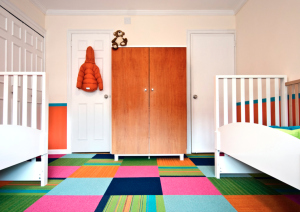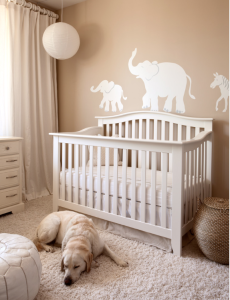Know the right solutions and when to use them to prevent stains from pets, soda, chocolate, blood and more!
If you’ve ever had a carpet freshly cleaned or rolled out a new area rug only to watch in horror as it became a stain magnet for everything from pet accidents to spilled wine and dirty shoes, you know the feeling: part panic, part action hero that transforms even the mildest-mannered among us into grime fighters.
It’s an occurrence that experts in the area of carpet care know well. In fact, when it comes to spot removal, pros like the ones at Coit carpet cleaning and the Carpet and Rug Institute (CRI) are nothing short of stain-fighting superheroes. The best part? You can be one, too. Cape optional. Here’s how.
Scene of the Grime
Act fast. When a stain happens, act quickly. The CRI says since most carpets today are made to be stain-resistant, many accidents can be remedied if you get to them in time. The longer the delay, the higher the chance of something becoming permanent.
Blot, don’t scrub. Using a white cloth or ink-free paper towels (to avoid the danger of additional dyes bleeding into the carpet), blot the stain. Avoid using a scrubbing motion, which can cause the spot to spread or work the problem deeper into the carpet fibers. Keep blotting until the area is completely dry.
Scrape. If semisolids are part of the problem, scrape them off the floor carefully with a rounded spoon. Vacuum the solids until they’re completely removed.
Spot On
Before treating a rug stain with a spot-removal product, test it out on an inconspicuous area first. The CRI says this is an important step, because some cleaning solutions can cause damage. Its advice: Apply several drops to the testing area and hold a white cloth on the wet area for 10 seconds. Next, check the carpet and the cloth for color transfer or visible damage to the rug. If you notice color coming off onto the cloth or discoloration on the rug, test another product.
 Once you have identified a safe cleaning solution, the CRI advises applying a small amount to the stain and letting it sit for about 10 minutes. Next, working from the outside edges of the stain inward, gently blot the spot. Repeat as needed.
Once you have identified a safe cleaning solution, the CRI advises applying a small amount to the stain and letting it sit for about 10 minutes. Next, working from the outside edges of the stain inward, gently blot the spot. Repeat as needed.
The CRI says in many cases, patience is the most important superpower, and it may be necessary to repeat the same step several times.
After the stain has been completely removed and a brief happy dance has ensued, it’s time to rinse the treated area thoroughly with lukewarm tap water and blot dry (again with the blotting!) until all the cleaning solution has been removed. The CRI warns that some products will cause staining and spotting of their own if they are not rinsed completely.
To dry, stack a half-inch layer of plain paper towels on the spot and weigh it down with a flat, heavy object (or stand on it). Continue the process, changing paper towels as needed, until the excess water has been absorbed and the carpet is dry.
If you feel the need for speed, the CRI suggests using a dry, absorbent cleaning compound (such as Capture) to accelerate the drying time.
Knowledge is power. Knowing what kind of stain you are dealing with will determine the best course of action. Here’s how to attack some of the most common rug and carpet stains.
Coffee, tea, cola. One of the CRI’s most recommended methods for cleaning a variety of stains begins with a combination of ¼ teaspoon of liquid dishwashing detergent with 1 cup of lukewarm water. According to the experts, although you may be tempted to add more dish soap, don’t do it. The less soapy residue you have to rinse out at the end, the better.
To create the solution, use a mild dish soap, never a laundry detergent or an automatic dishwashing detergent, since those often contain optical brighteners or bleaching agents, which can harm carpet dyes and fibers.
If the stain is stubborn, follow the dish soap solution with a mixture of 1 cup of white vinegar per 2 cups of water. The CRI says that since white vinegar is a 5 percent acetic acid solution, it acts as a solvent that will work on both the stain and the dish soap residue.
Finally, when it’s time to rinse the area, the CRI advises using lukewarm tap water in a spray bottle. This precaution is aimed at avoiding oversaturating the carpet and harming the layers beneath. Blot with paper towels and pat dry after each rinse. Several rinses may be necessary to thoroughly eliminate the residue.
 Pet potty spots. It’s not just the carpet stain but the lingering odor of pet accidents that concerns most homeowners. After the mess has been cleaned up, treat the stain with a product dedicated to pet stains or use the DIY dish soap solution. Blot until almost dry.
Pet potty spots. It’s not just the carpet stain but the lingering odor of pet accidents that concerns most homeowners. After the mess has been cleaned up, treat the stain with a product dedicated to pet stains or use the DIY dish soap solution. Blot until almost dry.
The Humane Society suggests that after you remove the stain, use a high-quality pet odor neutralizer, which can be found at most pet supply stores. It cautions against using cleaning agents with strong odors, such as ammonia or vinegar, which it says may encourage your pet to reinforce the scent of urine in that area.
One DIY method for neutralizing the scent, recommended by the experts at Coit: Mix ½ cup of 3 percent hydrogen peroxide with 1 teaspoon of a mild liquid dish soap, and put it in a spray bottle. Then sprinkle one to two handfuls baking soda (depending on the size of the stain) over the area and spray with the soapy solution. Gently massage the dissolving baking soda into the carpet and allow the spot to dry completely. Finish by vacuuming.
As with all stains, test the process on carpet in an out-of-the-way spot first.
 Blood. If blood gets on your carpet, I’m guessing the first thing that comes to mind isn’t how you’re going to clean the rug. Once the emergency has passed, however, it’s time to address the mess — and quickly.
Blood. If blood gets on your carpet, I’m guessing the first thing that comes to mind isn’t how you’re going to clean the rug. Once the emergency has passed, however, it’s time to address the mess — and quickly.
If the blood has dried, gently loosen it with a wire brush to remove surface debris. Then use the dish soap solution with cold water to clean and blot.
It’s important to note that bloodstains should be treated with cold water, not hot, because heat may cause the stain to set permanently.
If repeated cleaning and blotting with the dish soap solution doesn’t do the trick, Coit suggests an alternative option: Mix ½ cup of water with 1 tablespoon of ammonia. Using a cloth or sponge, apply the ammonia solution on the blood stain. Blot until the liquid is fully absorbed. Finally, apply a sponge dipped in cold water to the stain and blot until dry.
 Chocolate. The professionals at Coit offer this advice for removing chocolate stains: First scrape off as much of the dried chocolate as you can. Next vacuum the stained area to remove any remaining flakes.
Chocolate. The professionals at Coit offer this advice for removing chocolate stains: First scrape off as much of the dried chocolate as you can. Next vacuum the stained area to remove any remaining flakes.
Once the area has been cleaned, cover the spot with paper towels and set an iron to the lowest nonsteam setting. When the iron is warm, move it slowly over the paper towels. The chocolate should melt and stick to the paper towels. Keep the temperature steady, and as the paper towels absorb the chocolate, replace them with clean ones. Repeat until the stain has disappeared.
Another approach: The CRI recommends using a solvent, a nonflammable spot solution or a dry-cleaning-type solvent on chocolate stains as the first line of defense. It advises to never pour a solvent directly onto the carpet, since it might permeate the layers and damage the latex that binds the primary and secondary backings. The recommended solvents are Carbona, Energine, K2R and Goof-Off.
 Wax. The experts at Coit advise attacking candle drippings on the carpet first with a bag of ice. Place the ice over the spot and let it freeze for a few minutes. Next, remove the bag and scrape off the dried wax with the edge of a butter knife. Vacuum up any remaining pieces. If wax residue remains, place a brown paper bag or clean cloth over the spot and, using a warm iron on a low nonsteam setting, move gently over the bag or cloth. The heat will cause the residue to be absorbed into the bag or cloth. Repeat with a fresh bag or cloth until the residue is gone.
Wax. The experts at Coit advise attacking candle drippings on the carpet first with a bag of ice. Place the ice over the spot and let it freeze for a few minutes. Next, remove the bag and scrape off the dried wax with the edge of a butter knife. Vacuum up any remaining pieces. If wax residue remains, place a brown paper bag or clean cloth over the spot and, using a warm iron on a low nonsteam setting, move gently over the bag or cloth. The heat will cause the residue to be absorbed into the bag or cloth. Repeat with a fresh bag or cloth until the residue is gone.
If a colored candle leaves a stain, pour a small amount of rubbing alcohol onto a clean white cloth and gently dab at the stain. Blot the carpet until it is dry.
 Ink markers. Everyone loves a good art project, just not on the carpet. If a petite Picasso has left a mark on your rug, there are several options for taking care of the stain.
Ink markers. Everyone loves a good art project, just not on the carpet. If a petite Picasso has left a mark on your rug, there are several options for taking care of the stain.
Coit recommends dabbing the ink stain with either rubbing alcohol or a cheap lacquer hairspray. Use a white towel to blot the spot — the pros say you should see the color transferring from the carpet to the cloth. Once the area is stain-free, dab the area to rinse away residue with a damp towel. If color remains on the carpet, repeat the process using more hairspray. The bad news: Although you may be able to lighten or reduce the stain in some cases, permanent markers are in fact permanent. Still, it’s worth a try.
Tomato sauce. Mamma mia! To get a tomato sauce stain out, act quickly. Work from the outside of the stain toward the inside, and use a spoon or the edge of a knife to remove any excess sauce from the carpet, according to Coit. Next, pour a generous amount of club soda onto the affected area of the carpet and use a damp sponge to blot up the stain. Then, take a clean paper towel and press it onto the area to absorb moisture or residue.
Finally, treat the spot using the dish soap solution, then blot, rinse and dry.
 Grease stains. Cheese pizza hit the floor facedown? Fried chicken slipped off the platter? Coit advises the following:
Grease stains. Cheese pizza hit the floor facedown? Fried chicken slipped off the platter? Coit advises the following:
Blot up as much of the grease stain as possible, then apply something like cornmeal, which will act to absorb the grease. After a few minutes, use a brush with stiff bristles to brush away the stain and break it up. If the spot is still there, Coit suggests trying a dry-cleaning solvent, such as Afta cleaning fluid, and applying it with a clean sponge according to the directions.
Next, create what Coit calls a dry spotter, made by combining 8 parts liquid dry-cleaning solvent and 1 part coconut oil. Mineral oil works too, but not as effectively. Apply the mixture to the stain. Blot with a dry, absorbent towel or pad and repeat as needed.
As with all spot-cleaning remedies, be sure to test on an out-of-the-way piece of carpet first.
Spots on Sisal and Sea Grass
Sisal and sea grass complement a variety of interior design styles, but they can also be tricky to spot clean, which is why the pros at Sisal Carpet have posted a comprehensive spot removal chart on the company’s website that addresses everything from alcoholic beverages to vomit.
 As an example, here’s what they suggest for cleaning a wine stain on sisal:
As an example, here’s what they suggest for cleaning a wine stain on sisal:
To begin, immediately blot (do not rub) the spill with white paper towels or a clean, absorbent cloth. Sprinkle on an absorbent powder such as salt or talc, then add cold water and blot. Finally, dab on the mild detergent solution, being careful not to saturate the sisal. Work inward from the edge of the spot to prevent the stain from spreading. Wait a few minutes to give the detergent time to work, then blot the moisture with paper towels or an absorbent cloth. Rinse with clear water applied to a clean cloth. Do not pour the water directly on the carpet. Finally, remove excess moisture by applying pressure with paper towels.
 Professional Help
Professional Help
Sometimes, in spite of our best efforts, stubborn stains or spots on vintage or delicate rugs may require the attention of a hired gun, in this case a carpet-cleaning professional.
Article published on Houzz.com





Sorry, the comment form is closed at this time.